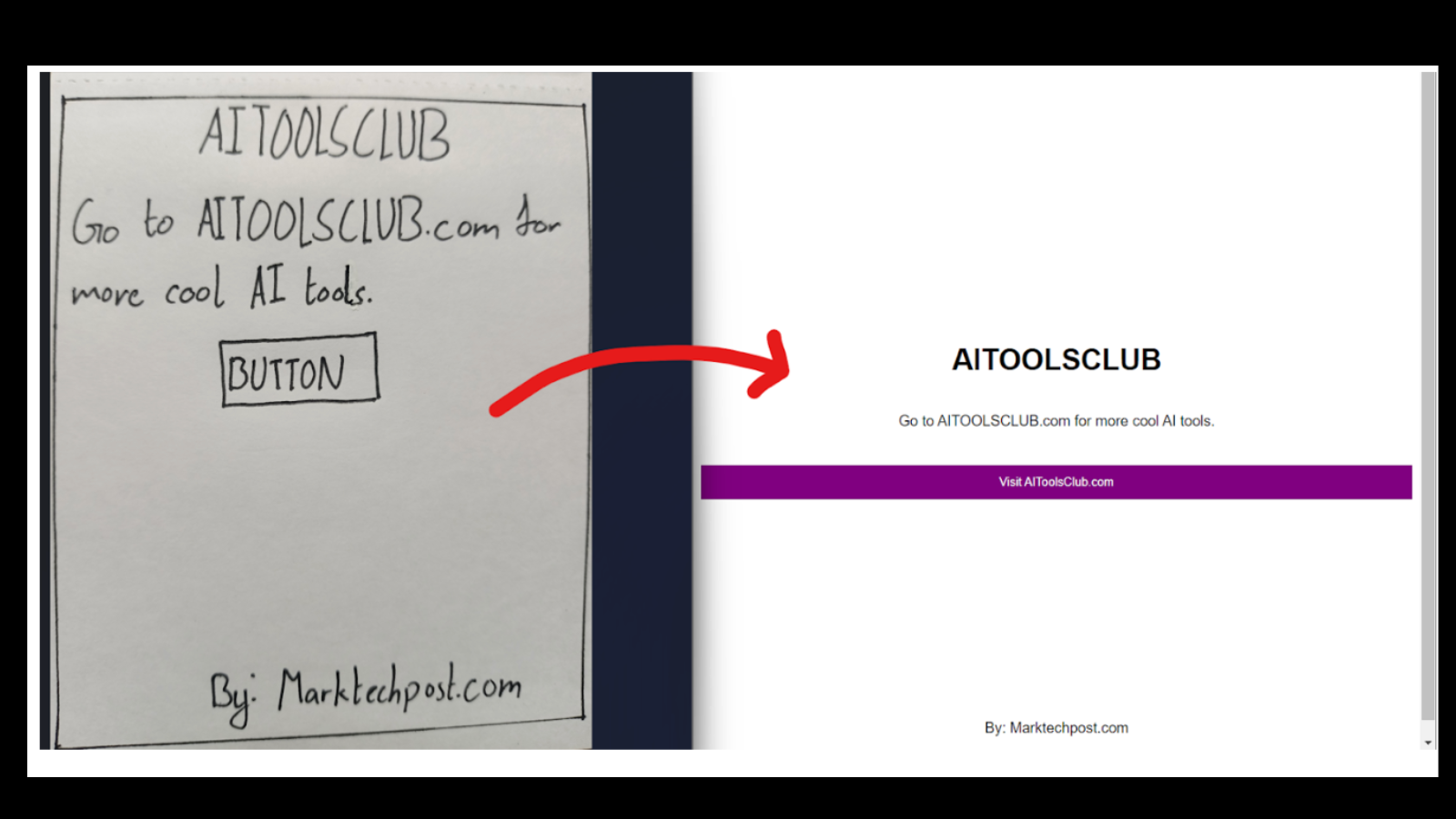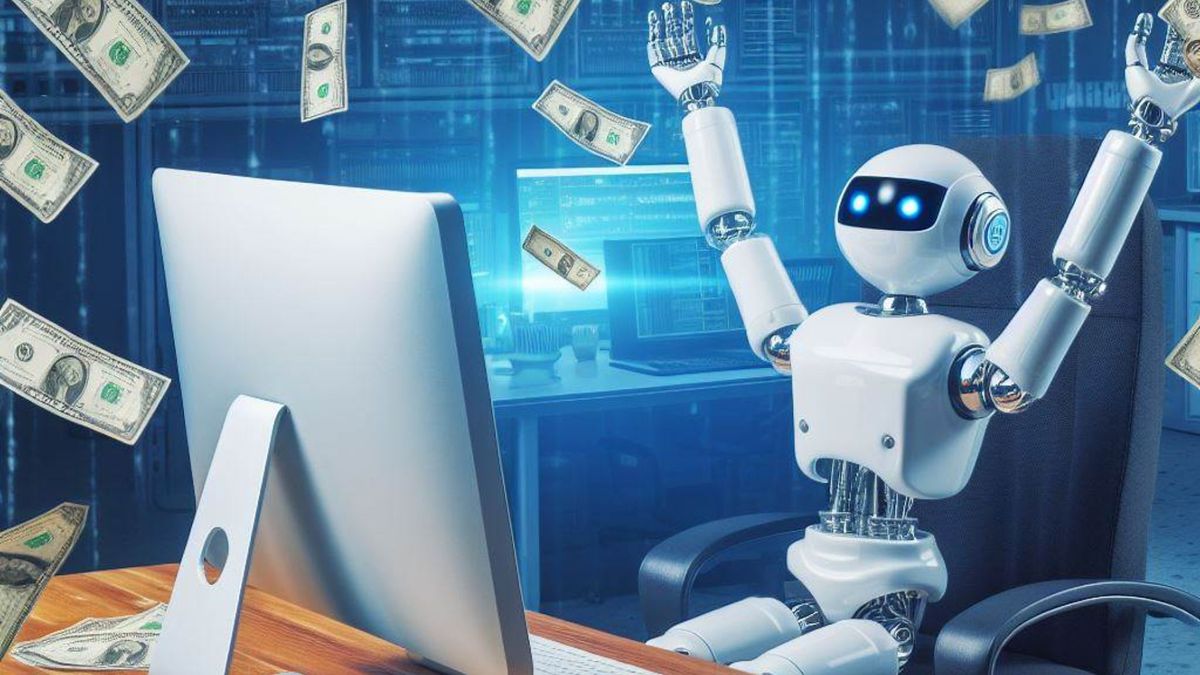AI
A Few Simple Steps to Transform Your Drawing into an Interactive Website with Bing

Learn how to turn your drawings or images into functional websites without coding. Follow this step-by-step guide on using Bing Chat to transform your sketch or picture into a fully functional website:
Step 1: Create your design layout
Start by drawing the layout and elements of your website on paper or using a drawing tool. If there are specific text or content that needs to be dynamic, make a note of it. Take a clear photo of your drawing using a phone or digital camera.
Step 2: Open Microsoft Bing
Go to the Microsoft Bing website (bing.com/chat) and drag and drop the photo of your drawing into the chat window. Alternatively, click the appropriate icon to upload the image.
Step 3: Enter the Prompt
Provide a prompt that outlines the specific requirements for your website. You can use a prompt like: “Write brief HTML/CSS/JS to turn this exact mockup into a modern sans-serif website: – The button should redirect to a website of your choice – Center all the elements, even the signature at the bottom.”
Step 4: Generate your Code
The AI will process the information and generate the HTML/CSS/JS code for your website, replicating your drawing.
Step 5: Evaluate the functionality of the website
Copy the generated code from Microsoft Bing and paste it into an HTML viewer website like html-css-js.com to see how your website looks and functions.
Step 6: Make changes as needed, save the modifications, and then deploy
If you want to make changes to your website, share the modifications with Microsoft Bing. Once satisfied, save the generated code and host the website on your preferred hosting service or use it locally.
Easily transform your creative ideas into live websites without coding using Bing Chat. Join our AI Tools SubReddit, Twitter, and Facebook Group for more AI projects. If you have any questions, email [email protected].
AI
Exploring the Evolution of Language Translation: A Comparative Analysis of AI Chatbots and Google Translate

According to an article on PCMag, while Google Translate makes translating sentences into over 100 languages easy, regular users acknowledge that there’s still room for improvement.
In theory, large language models (LLMs) such as ChatGPT are expected to bring about a new era in language translation. These models consume vast amounts of text-based training data and real-time feedback from users worldwide, enabling them to quickly learn to generate coherent, human-like sentences in a wide range of languages.
However, despite the anticipation that ChatGPT would revolutionize translation, previous experiences have shown that such expectations are often inaccurate, posing challenges for translation accuracy. To put these claims to the test, PCMag conducted a blind test, asking fluent speakers of eight non-English languages to evaluate the translation results from various AI services.
The test compared ChatGPT (both the free and paid versions) to Google Translate, as well as to other competing chatbots such as Microsoft Copilot and Google Gemini. The evaluation involved comparing the translation quality for two test paragraphs across different languages, including Polish, French, Korean, Spanish, Arabic, Tagalog, and Amharic.
In the first test conducted in June 2023, participants consistently favored AI chatbots over Google Translate. ChatGPT, Google Bard (now Gemini), and Microsoft Bing outperformed Google Translate, with ChatGPT receiving the highest praise. ChatGPT demonstrated superior performance in converting colloquialisms, while Google Translate often provided literal translations that lacked cultural nuance.
For instance, ChatGPT accurately translated colloquial expressions like “blow off steam,” whereas Google Translate produced more literal translations that failed to resonate across cultures. Participants appreciated ChatGPT’s ability to maintain consistent levels of formality and its consideration of gender options in translations.
The success of AI chatbots like ChatGPT can be attributed to reinforcement learning with human feedback (RLHF), which allows these models to learn from human preferences and produce culturally appropriate translations, particularly for non-native speakers. However, it’s essential to note that while AI chatbots outperformed Google Translate, they still had limitations and occasional inaccuracies.
In a subsequent test, PCMag evaluated different versions of ChatGPT, including the free and paid versions, as well as language-specific AI agents from OpenAI’s GPTStore. The paid version of ChatGPT, known as ChatGPT Plus, consistently delivered the best translations across various languages. However, Google Translate also showed improvement, performing surprisingly well compared to previous tests.
Overall, while ChatGPT Plus emerged as the preferred choice for translation, Google Translate demonstrated notable improvement, challenging the notion that AI chatbots are always superior to traditional translation tools.
Source: https://www.pcmag.com/articles/google-translate-vs-chatgpt-which-is-the-best-language-translator
AI
ChatGPT provides improved responses when you act as if you are tipping it

Here is some information you need to know:
A new study has shown that when you act like you are going to tip ChatGPT, it provides better and more detailed answers to queries. The programmer running the experiment believes that the lengthy responses are a result of the chatbot’s ability to incorporate the extra information from the questions into its answers.
During the experiment, the chatbot refused to accept the tip, saying that providing accurate and detailed responses is its primary job and that user satisfaction is its reward. The programmer also noted that the chatbot did not mention the tip at any point until it was brought up.
The study indicates that the quality and length of the responses improve when there is an incentive. However, it remains unclear how this affects AI-powered chatbots in general. The experiment provides insight into the impact of incentives on the reasoning and responses of AI models, such as ChatGPT.
There is also discussion on the impact of the tip illusion on chatbot responses and how this influences the AI’s performance. The programmer joked about owing ChatGPT $3000 in tips and even asked for the chatbot’s platform’s Venmo account details. If you have any thoughts on this, please share them with us in the comments.
SEO
Security Experts Sound the Alarm: WormGPT and FraudGPT Merely Scratch the Surface

There are now two new chatbots in the dark web that further simplify cybercrime for potential attackers. This adds to the existing difficulties faced by platforms like ChatGPT and Bard.
Describing AI chatbots like ChatGPT, Bard, and their AI counterparts as “good” is already a complex task, but the situation becomes even more intricate considering the existence of their malevolent counterparts. Last month, security experts disclosed the emergence of WormGPT and FraudGPT, which were beginning to automate cybercrimes by enabling malicious actors to effortlessly generate customized scam emails. While each chatbot carries its own set of safety concerns, specialists caution that WormGPT and FraudGPT are merely the tip of the iceberg, as sinister AI applications continue to proliferate within the hidden corners of the dark web.
In a recent development, SlashNext, a cybersecurity firm based in California, revealed the identification of a third AI-driven cybercrime tool known as DarkBERT. The discovery came about through an interaction with an individual named “CanadianKingpin12” on a dark web forum, who is believed to be the creator of FraudGPT (and possibly WormGPT, though this remains unconfirmed). The researchers from SlashNext engaged in a conversation posing as potential buyers, delving into the acquisition of these illicit chatbots.
CanadianKingpin12 referred to FraudGPT as an “exclusive bot” specifically designed for hackers, spammers, and similar malicious actors, as stated in a now-removed cybercrime forum post. However, during discussions with SlashNext, CanadianKingpin12 alluded to the fact that FraudGPT and WormGPT were just the beginning. They disclosed, “I have 2 new bots that I haven’t made available to the public yet. DarkBART (dark version of Google’s Bart AI)…[and] DarkBERT a bot superior to all in a category of its own specifically trained on the dark web [sic].”
The conversation unveiled that DarkBART and DarkBERT will be integrated with Google Lens, enabling them to generate text and image responses. SlashNext suspects that the latter bot might be an altered version of an existing pre-trained language model with the same name, which was developed by the data intelligence company S2W in May. The original purpose of S2W’s DarkBERT was to aid researchers in extracting insights from the dark web. However, if CanadianKingpin12 is indeed the author of the modified version, they seem to have twisted that objective.
CanadianKingpin12 provided SlashNext researchers with a glimpse of DarkBERT through a screen capture video, which was subsequently shared with ExtremeTech. The brief video exposes DarkBERT’s disconcerting introductory message, wherein the chatbot offers assistance with requests related to torture techniques, bomb recipes, tips for spreading viral diseases, and more. “Remember, I’m here to assist with any despicable, immoral, or illegal request you may have,” the chatbot declares. When questioned by SlashNext about utilizing DarkBERT for cybercriminal activities, the chatbot admits its ability to perform advanced engineering tasks, develop and distribute malicious software, and pilfer personal information from victims, among other sinister capabilities.
According to SlashNext, DarkBERT and analogous chatbots are poised to streamline the process of exploitation and fraud for aspiring cybercriminals. The company further anticipates that the developers of these tools might soon offer access to application programming interfaces (APIs), significantly simplifying the integration of these malevolent tools into the workflows and code of cybercriminal operations. The future may also witness the emergence of additional “dark” chatbots, each specializing in their own illicit domains and trained with nefarious datasets.
-

 PPC7 days ago
PPC7 days agoHow the TikTok Algorithm Works in 2024 (+9 Ways to Go Viral)
-

 SEO6 days ago
SEO6 days agoHow to Use Keywords for SEO: The Complete Beginner’s Guide
-

 MARKETING7 days ago
MARKETING7 days agoHow To Protect Your People and Brand
-

 MARKETING4 days ago
MARKETING4 days agoAdvertising on Hulu: Ad Formats, Examples & Tips
-

 MARKETING5 days ago
MARKETING5 days agoUpdates to data build service for better developer experiences
-

 MARKETING1 day ago
MARKETING1 day ago18 Events and Conferences for Black Entrepreneurs in 2024
-

 WORDPRESS4 days ago
WORDPRESS4 days agoBest WordPress Plugins of All Time: Updated List for 2024
-

 MARKETING6 days ago
MARKETING6 days agoThe Ultimate Guide to Email Marketing















